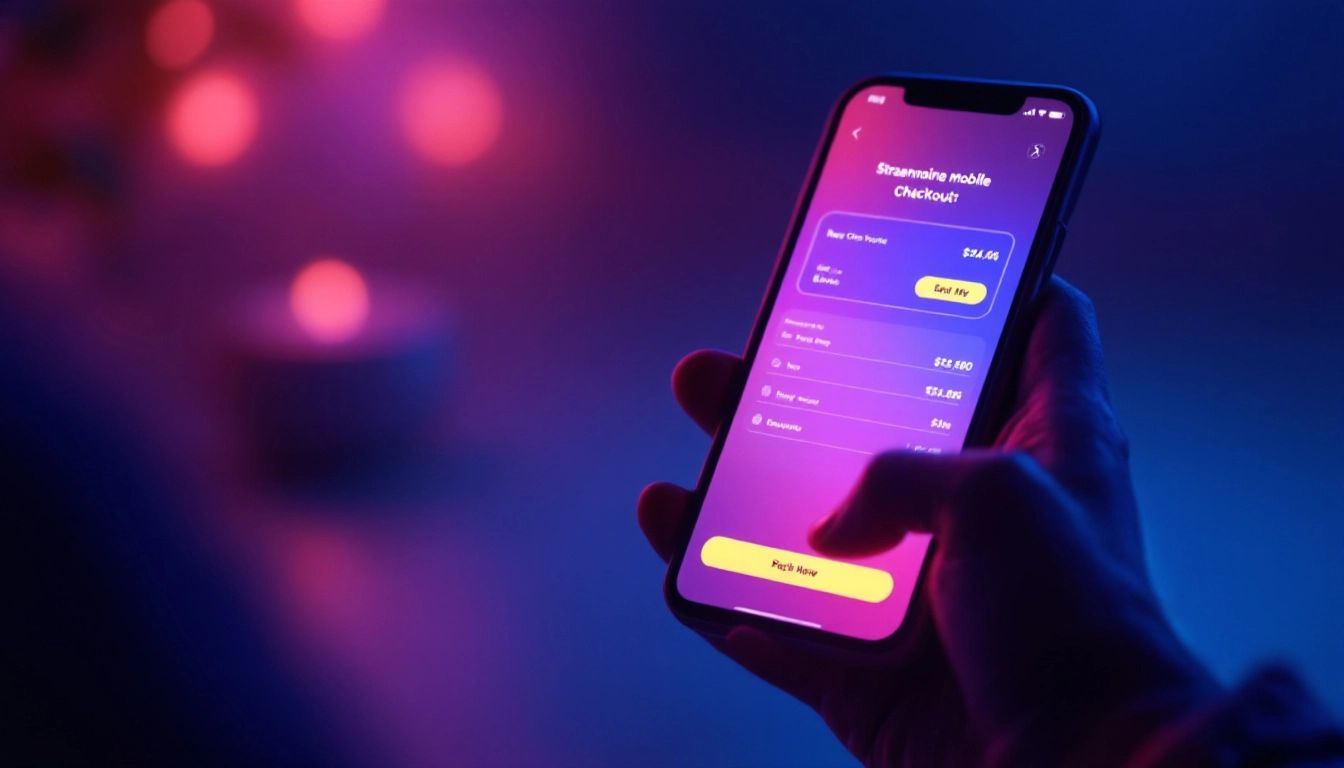Boost Sales with Shopify Add to Cart Links: A Comprehensive Guide
November 9, 2024

Understanding Add to Cart Functionality

The "add to cart" button is essential for any e-commerce business, and Shopify stores are no different. This simple button plays a vital role in the customer journey, connecting browsing with buying. Understanding how this feature works in Shopify, and its impact on your profits, is important for every store owner. Think of it as the virtual entrance to your checkout, and like a physical store, you want that entrance to be appealing, easy to find, and simple to use.
Why "Add to Cart" Matters
The "add to cart" link in Shopify does more than simply add items; it starts a process. It signals a customer's intention to buy, providing you with valuable data about customer behavior and product popularity. By monitoring "add to cart" actions, you can spot popular products, identify potential problems in your sales process, and find opportunities for upselling or cross-selling. For example, if a product is added to carts frequently but has low sales, it might suggest a problem with the product description, pricing, or shipping choices. This data helps you make informed choices and improve your store for better sales.
A smooth "add to cart" process is crucial for a positive user experience. A slow, confusing, or poorly designed button can frustrate customers and lead to abandoned carts. Every click matters, and a simple experience encourages customers to proceed to checkout.
The Power of the "Add to Cart" Link Shopify Provides
Beyond the standard button, Shopify offers flexible options for creating "add to cart" links that can be strategically used in your marketing. Imagine a direct link to a pre-filled cart with a specific product and an automatic discount. This tool lets you create targeted campaigns and personalized shopping experiences. You can share these custom "add to cart" links in emails, social media posts, or even QR codes, directing customers to specific products or collections and making buying easier. This control can effectively increase sales and highlight specific items. For example, promoting a limited-time sale with a pre-filled cart and an automatic discount can greatly improve sales by reducing the steps needed to buy.
Direct, pre-filled "add to cart" links offer a big advantage over simply linking to a product page. By simplifying the purchase process, you remove obstacles and increase the chance of a completed sale. This approach works well for limited-time offers, flash sales, or when promoting specific items to certain customer groups. This focused marketing can be a game-changer for your Shopify business.
Step-by-Step Implementation Guide
Now that we understand the benefits of a well-designed "add to cart" link in Shopify, let's look at the practical steps. This section offers a technical guide on implementing and using this feature to increase your sales.
Direct "Add to Cart" Links
One of the best ways to use the "add to cart" feature is by creating direct links. These links send the customer directly to their cart with the selected item already added, simplifying the buying process. The structure for a direct "add to cart" link in Shopify is:
https://your-store-name.com/cart/add?id=VARIANT_ID&quantity=QUANTITY
your-store-name.com: Replace this with your Shopify store's URL.VARIANT_ID: This unique number identifies a specific product variation (like size or color). Find this ID in your Shopify product admin.QUANTITY: Enter the number of products to be added to the cart.
For example, suppose you sell t-shirts, and the blue, large version has a VARIANT_ID of 1234567890. To add one to the cart, the link would be:
https://your-store-name.com/cart/add?id=1234567890&quantity=1
To add two t-shirts to the cart, change the link to:
https://your-store-name.com/cart/add?id=1234567890&quantity=2
This small change can make a big impact. Imagine a sale where customers get a discount when they buy two of the same item. This link skips the usual process and gets them ready to check out. This is especially useful in social media or email marketing, guiding traffic to a purchase-ready cart.
Using "Add to Cart" Links with Multiple Products
Adding multiple products to the cart with a link is also simple. Just add more id and quantity parameters for each product. For example, to add a blue t-shirt (VARIANT_ID: 1234567890) and a red t-shirt (VARIANT_ID: 0987654321), the link would be:
https://your-store-name.com/cart/add?id=1234567890&quantity=1&id=0987654321&quantity=1
You might be interested in: How to master your Shopify Add to Cart links further.
This allows you to create promotional bundles, offer curated collections, or even prepare pre-filled carts for specific customer groups, making your marketing more personalized and successful. Using direct add to cart links with email and even influencer marketing can significantly boost average order values and improve sales.
With these methods, the "add to cart link Shopify" feature becomes a valuable tool for boosting sales and improving the customer journey. This precise control allows you to customize every interaction, addressing specific customer needs and ultimately increasing your profits.
Customizing Your Add to Cart Button

We've covered the functionality and implementation of the "add to cart link Shopify" system, but let's talk about design. Your "add to cart" button is not just functional; it's a vital part of your brand and user experience. A well-designed button can greatly influence your sales. A plain button might be ignored, while a noticeable, well-placed button encourages purchases.
Styling Your Button for Conversions
Shopify provides some built-in customization for your add to cart buttons. You can adjust color, size, and shape in your theme editor. But for truly unique buttons, you may need some CSS. It’s not as hard as it seems! Even a little code can make a difference.
Consider your customers and store design when styling your buttons. A luxury brand might choose a simple button, while a young, energetic brand could use a bolder, more colorful one. If you sell eco-friendly items, using natural colors and textures reinforces your brand message. If you're unsure what works best, testing different button styles can provide valuable feedback.
Placement is Key
Where you put your add to cart button is as important as how it looks. Ensure it's visible on product pages, easy to spot, and near the top of the page when possible. Customers shouldn't have to search for it. It should be clear, simple, and immediately visible.
Consider the flow of your product page. Does it guide customers towards the add to cart button? Studies show users often follow an F-shaped pattern when viewing web pages, so placing your button along this pattern can improve visibility. Ensure the button works well on all devices, including mobile phones and tablets.
Beyond the Basics: Advanced Customization with "Add to Cart Link Shopify" Functionality
Take your button customization further by integrating it with the "add to cart link Shopify" feature. Create custom buttons for specific sales or product bundles. A button that says "Add to Cart & Get 20% Off" is a powerful call to action! This type of personalization can greatly increase clicks and sales.
Your "add to cart" button is a gateway to sales. By carefully considering its design, placement, and use of Shopify's link feature, you can improve the customer journey and boost sales. This not only simplifies buying but also shows professionalism and attention to detail, strengthening your brand image. Remember, every part of your online store contributes to the overall customer experience, and a well-designed add to cart button plays a crucial role in turning browsers into buyers.
Mobile Optimization

Now that we've explored the look and placement of your "add to cart" button, let's discuss making it work perfectly on mobile devices. With most online shopping happening on phones, optimizing your "add to cart link Shopify" experience for mobile is essential. A smooth mobile experience significantly impacts your sales. Studies show mobile optimization can improve "add to cart" conversions by a significant margin. Ignoring mobile users means losing potential sales.
Responsive Design is Non-Negotiable
Your Shopify theme must be responsive. This means it automatically adjusts to different screen sizes, providing a consistent experience across devices. Most modern Shopify themes are responsive, but if you have an older theme, you should consider updating or customizing it for mobile devices. A non-responsive site can frustrate mobile users and lose sales.
Optimizing "Add to Cart" Links for Mobile
Consider how customers use their phones. They scroll, tap, and often browse one-handed. Your "add to cart link Shopify" buttons must be easily accessible with a thumb. Placement is key; avoid placing buttons in hard-to-reach spots. Test different button placements to find the best position for better sales. What works on a desktop might not work on mobile.
Button size is also important. Small buttons are hard to tap. Ensure your buttons are large enough for easy tapping, even on small screens. A minimum size of 44 x 44 pixels is recommended.
The Importance of Speed
Mobile users are impatient. A slow website can quickly lead to abandoned carts. Optimize your website's speed by compressing images, reducing redirects, and using browser caching. Every millisecond matters. Studies show that even a one-second delay in page load time can reduce sales. Test your site's mobile speed using tools like Google PageSpeed Insights and fix any performance issues. This could include optimizing images, minimizing HTTP requests, and using a Content Delivery Network (CDN). A fast mobile experience keeps customers engaged and leads them towards checkout.
By prioritizing mobile optimization and creating a seamless "add to cart link Shopify" experience on phones, you can reach more customers, improve sales, and ultimately make your online store more successful. Mobile is the future of e-commerce, and your Shopify store needs to be prepared.
Performance Optimization
A fast "add to cart" experience is vital for any Shopify store. A perfectly designed "add to cart link Shopify" button is useless if the page loads slowly. Slow loading times can dramatically reduce sales. Customers expect a quick, seamless experience, and any delay can cause frustration and lost sales. How can we ensure our Shopify store is optimized for speed, especially for the add to cart feature?
Minimize Redirects and HTTP Requests
Excessive redirects and HTTP requests are common causes of slow page loading. Each redirect adds another step, increasing the time it takes for the page to load. Similarly, each HTTP request (for images, scripts, stylesheets, etc.) adds overhead. Reducing both can improve "add to cart link Shopify" functionality. Think of it as a relay race: fewer handoffs mean a faster overall time.
A Content Delivery Network (CDN) is a good solution. A CDN stores copies of your website's static files (like images and scripts) on servers worldwide. Customers access these files from a server closer to them, reducing delays and improving load times.
Optimize Images and Code
Large image files slow down page loading. Compressing images without losing quality is crucial. Many tools can help with this, both online and within Shopify. Clean, efficient code is also vital. Reduce unnecessary code and remove redundant scripts or stylesheets. It's like decluttering – less excess baggage makes things easier to find.
Lazy loading is another important technique. It delays image loading until they are needed, meaning images further down the page won't load until the user scrolls to them. This greatly improves initial load times, especially on image-heavy product pages.
Leverage Browser Caching
Browser caching lets users' browsers save some website files locally. This means the browser doesn't have to download these files again on future visits, resulting in much faster loading. Setting up your server to use browser caching can significantly improve the performance of your "add to cart link Shopify" feature, ensuring a smooth experience for returning customers. It's like a shortcut – the browser remembers the route and gets there faster next time.
By using these performance techniques, your "add to cart link Shopify" feature is both effective and fast. This creates a good user experience, reduces abandoned carts, and increases your profits. In e-commerce, speed is critical, and every millisecond counts.
Conversion Rate Optimization

We've covered implementing and customizing your "add to cart link Shopify" setup. Now, let's focus on the most important part: increasing your sales. A good "add to cart" button is useless if it doesn't lead to purchases. This involves understanding your customers, improving their shopping experience, and fully using the "add to cart link Shopify" feature. Your conversion rate – the percentage of visitors who complete a purchase – is the ultimate measure of your store's success. A higher conversion rate means more sales, higher revenue, and better profits.
Understanding the Customer Journey
Before discussing strategies, it’s crucial to understand the customer journey. Every interaction, from arrival to final purchase, shapes their experience. A smooth, intuitive journey leads to more sales, while a complicated one drives customers away.
Consider the steps a customer takes in your Shopify store. They browse, read reviews, and hopefully, click "add to cart." But the journey continues. They need to navigate checkout, enter shipping information, and pay. Each step can be improved. Carefully analyze each stage to find potential problems and streamline the process.
Leveraging the Power of the "Add to Cart Link Shopify" for Higher Conversions
The "add to cart link Shopify" system has powerful tools for improving the customer journey and increasing sales. One method is creating targeted links with pre-filled carts and discounts. Imagine an email with a link that automatically applies a discount and fills the cart with featured items. This makes buying easier, encouraging purchases.
Another tactic is using these links with retargeting campaigns. If a customer adds an item to their cart but leaves without buying, a retargeting ad showing that item with a direct link to their cart can be very effective. Reminding customers of their initial interest and simplifying the purchase can recover lost sales.
A/B Testing for Continuous Improvement
Every store is different. A/B testing is crucial. Experiment with button placements, colors, call-to-action text, and product page language to find what works best for your audience.
For example, test two versions of your "add to cart" button: one with "Add to Cart" and another with "Buy Now." Track click-through rates and sales for each version to see which works better. This data-driven approach allows you to constantly improve and optimize your store. Read also: 20 Shopify Checkout Optimization Tips to Boost Sales.
The Power of Personalization
Personalization is key in e-commerce. Customers want a shopping experience tailored to their needs. The "add to cart link Shopify" feature enables this. By dividing your audience and creating personalized links for specific customer groups, your marketing becomes more relevant and effective. For example, create a specific link for customers who abandoned their carts, offering a discount or free shipping to encourage them to buy.
By using these strategies and analyzing your data, you can fully use your "add to cart link Shopify" feature and improve your store's sales. Optimization is ongoing. Staying ahead requires a data-driven approach, understanding your customers, and a willingness to experiment and adapt.
Ready to improve your Shopify store and boost sales with customized checkout links? Checkout Links offers a solution to streamline your customer journey and maximize conversions. Visit Checkout Links today for a free trial!
 Checkout Links
Checkout Links



